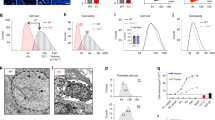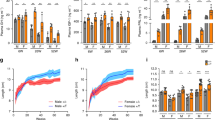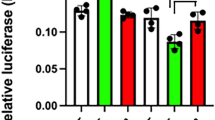Abstract
Epidermal growth factor (EGF) was originally characterized as a growth factor for various cell types1,2 and was subsequently shown to affect a number of cellular and molecular processes3,4, of which many might be considered as a part of the pleiotropic growth response (enhanced uptake of glucose, uridine and amino acids and stimulated synthesis of protein, RNA and DNA). Very early responses to EGF, such as increased sodium fluxes5 and stimulation of tyrosine phosphorylation6, have been proposed to mediate some or all of EGF's effects. In a number of tissues, EGF has been shown to increase the synthesis of specific proteins7–10. We have investigated the effects of EGF on prolactin synthesis in the GH4 rat pituitary cell line to gain further insight into the mechanism of EGF's actions on cellular functions. Addition of EGF to GH4 cells results in a three- to sixfold stimulation of prolactin synthesis, as well as a partial inhibition of cell growth7,8. In this report, we demonstrate that the increased prolactin synthesis appears to be the result of a rapid stimulation of prolactin gene transcription by EGF. It is tempting to speculate that very early transcriptional effects on specific genes, such as reported here in the case of the prolactin gene in GH4 cells, may mediate some or all of the later effects of EGF on cell cycle regulation in those cells for which it serves as a growth factor.
This is a preview of subscription content, access via your institution
Access options
Subscribe to this journal
Receive 51 print issues and online access
$199.00 per year
only $3.90 per issue
Buy this article
- Purchase on Springer Link
- Instant access to full article PDF
Prices may be subject to local taxes which are calculated during checkout
Similar content being viewed by others
References
Savage, C. R. & Cohen, S. J. biol. Chem. 247, 7609–7611 (1972).
Hollenberg, M. D. & Cuatrecasas, P. Proc. natn. Acad. Sci. U.S.A. 70, 2964–2968 (1973).
Carpenter, G. & Cohen, S. A. Rev. Biochem. 48, 193–216 (1979).
Rozengurt, E. Curr. Topics cell. Regulation 17, 59–88 (1980).
Rozengurt, E. & Heppel, L. A. Proc. natn. Acad. Sci. U.S.A. 72, 4492–4495 (1975).
Ushiro, H. & Cohen, S. J. biol. Chem. 255, 8363–8365 (1980).
Schonbrunn, A., Krasnoff, M., Westendorf, J. M. & Tashjian, A. H. Jr J. Cell Biol. 85, 786–797 (1980).
Johnson, L. K., Baxter, J. D., Vladavsky, I. & Gospodarowicz, D. Proc. natn. Acad. Sci. U.S.A. 77, 394–398 (1980).
Chen, L. B., Gudor, R. C., Sun, T. T., Chen, A. B. & Mosesson, M. W. Science 197, 776–778 (1977).
Benveniste, R. et al. J. clin. Endocr. Metab. 46, 169–172 (1978).
Ivarie, R. D., Morris, J. A. & Eberhardt, N. L. Recent Prog. Horm. Res. 36, 195–239 (1980).
Tashjian, A. H. Jr Meth. Enzym. 58, 527–535 (1979).
Bancroft, F. C. in Functionally Differentiated Cell Lines (ed. Sato, x. x.) 47–59 (Liss, New York, 19xx).
Potter, E., Nicolaisen, A. K., Ong, E. S., Evans, R. M. & Rosenfeld, M. G. Proc. natn. Acad. Sci. U.S.A. 78, 6662–6666 (1981).
Alwine, J. C., Kemp, D. J. & Stark, G. R. Proc. natn. Acad. Sci. U.S.A. 74, 5350–5354 (1977).
Murdoch, G. H., Rosenfeld, M. G. & Evans, R. M. Science (submitted).
Carpenter, C., King, L. & Cohen, S. Nature 276, 409–410 (1978).
Cohen, S., Carpenter, G. & King, L. J. biol. Chem. 255, 4834–4842 (1980).
Hunter, T. & Cooper, J. A. Cell 24, 741–752 (1981).
Rozengurt, E. & Mendoza, S. Ann. N.Y. Acad. Sci. 339, 132–138 (1980).
White, B. A., Bauerle, L. R. & Bancroft, F. C. J. biol. Chem. 256, 5942–5945 (1981).
Haigler, H. T., Maxfield, F. R., Willingham, M. C. & Pastan, I. J. biol. Chem. 255, 1239–1241 (1980).
Johnson, L. K., Vladavsky, I., Baxter, J. D. & Gospodarowicz, D. Nature 287, 340–343 (1980).
McKnight, G. S. & Palmiter, R. D. J. biol. Chem. 254, 9050–9058 (1979).
Compere, S. J., McKnight, G. S. & Palmiter, R. D. J. biol. Chem. 256, 6341–6347 (1981).
Author information
Authors and Affiliations
Rights and permissions
About this article
Cite this article
Murdoch, G., Potter, E., Nicolaisen, A. et al. Epidermal growth factor rapidly stimulates prolactin gene transcription. Nature 300, 192–194 (1982). https://doi.org/10.1038/300192a0
Received:
Accepted:
Issue Date:
DOI: https://doi.org/10.1038/300192a0
This article is cited by
-
Activating mutations in BRAF disrupt the hypothalamo-pituitary axis leading to hypopituitarism in mice and humans
Nature Communications (2021)
-
Bovine lactotroph cultures for the study of prolactin synthesis functions
In Vitro Cellular & Developmental Biology - Animal (2016)
-
Prolactinoma ErbB receptor expression and targeted therapy for aggressive tumors
Endocrine (2014)
-
Overexpression of urokinase-type plasminogen activator in pancreatic adenocarcinoma is regulated by constitutively activated RelA
Oncogene (1999)
-
Expression and regulation of transforming growth factor β1 in cultured normal and neoplastic rat pituitary cells
Endocrine Pathology (1996)
Comments
By submitting a comment you agree to abide by our Terms and Community Guidelines. If you find something abusive or that does not comply with our terms or guidelines please flag it as inappropriate.



